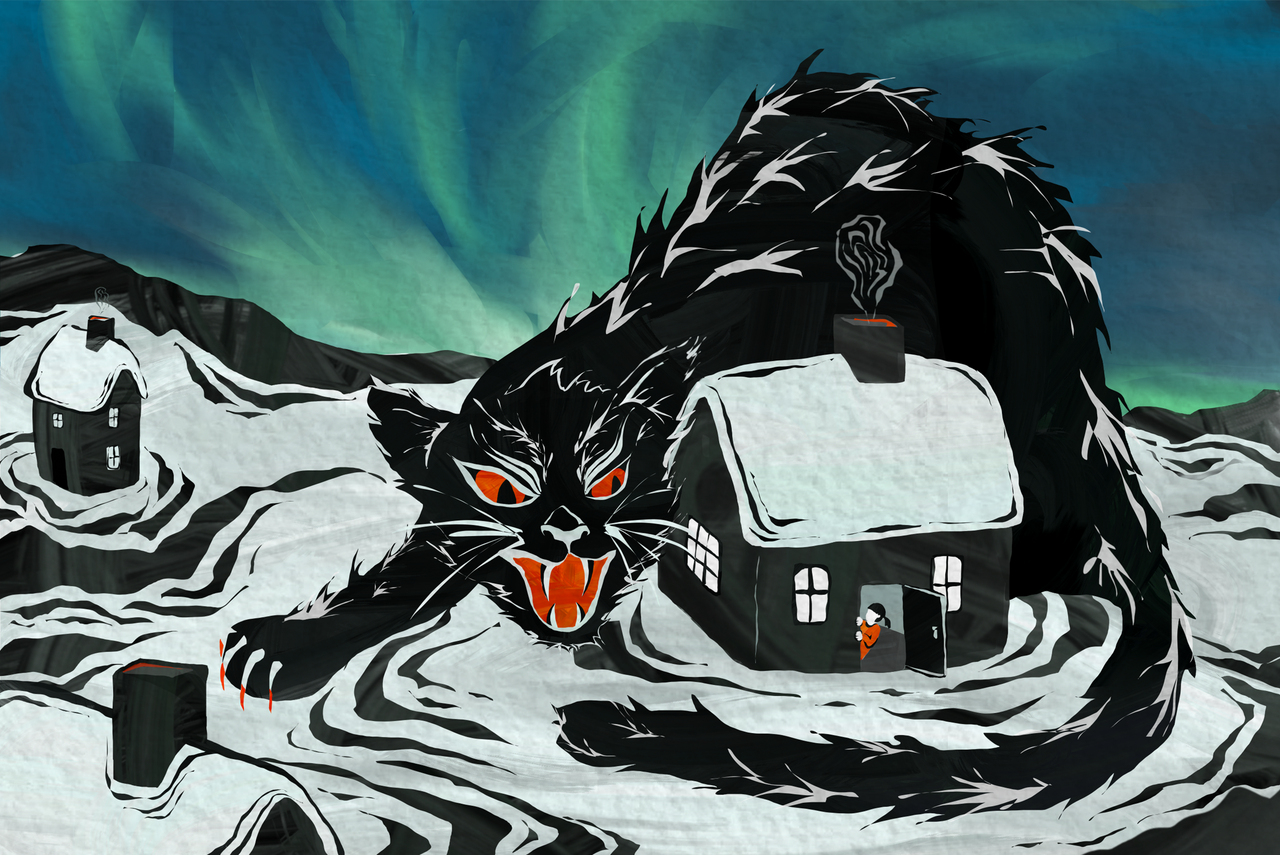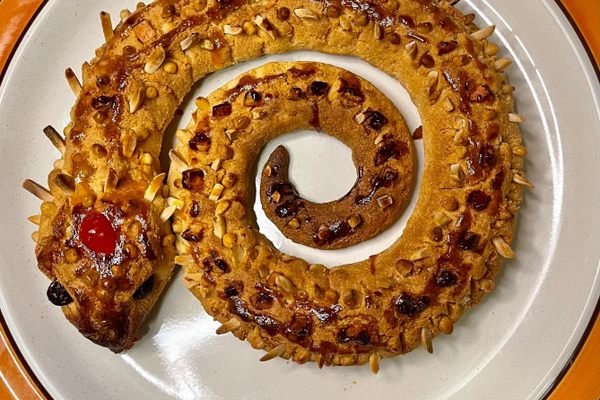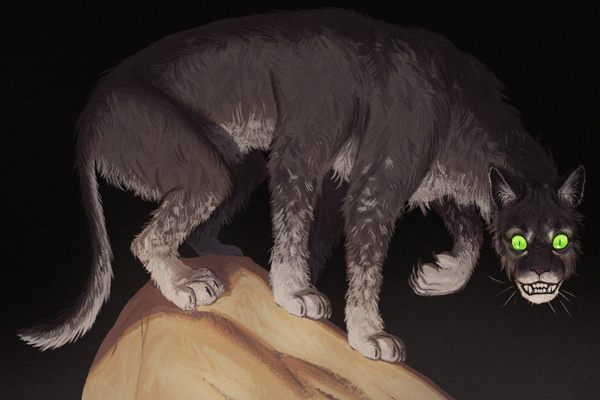Beware the Yule Cat, Iceland’s Child-Eating Christmas Monster
But if you’re wearing new clothes, you have nothing to fear from Jólakötturinn.
If you thought the ghost-filled plot of A Christmas Carol was a bit macabre for the holidays, you may want to steer clear of visiting Iceland anytime in December. Because Charles Dickens’ miserly Ebenezer Scrooge looks downright friendly when compared to Iceland’s meanest Christmas tale: Jólakötturinn, or the child-eating Yule Cat. Jólakötturinn is a black cat the size of a house that roams the Icelandic countryside on Christmas Eve, attacking and eating children who fail to wear at least one new piece of clothing.
The Yule Cat is something of a bribe for children: be good, and you’ll get a new sweater or pair of socks on Christmas. But if you misbehave, bad news: not only will you not get a new sweater, but you’ll be eaten by Jólakötturinn—in a horrific and ghastly way, no less.
For travelers unfamiliar with Iceland’s stories and mythical legends, the idea of a 12-foot-tall, bloodthirsty cat may not seem to have the most natural tie with Christmas good cheer. But in a country where a third of residents report a belief in hidden people and an entire school devoted to studying elves, Jólakötturinn starts to make sense.
“In our sagas, there are all types of monsters, and some of them are cat-related,” says Stefán Smári Ásmundarson, an Icelandic history expert and professional guide at the historical Caves of Hella.
In Iceland, perhaps no monster is more famous than Grýla, first mentioned in the early 13th-century historical saga, the Prose Edda. Grýla is said to both boil wayward children and command evil spirits. Her description varies, but it’s reliably unappealing, ranging from having three heads to 15 tails to large ears with goat horns.
The 18th century “Poem of Grýla” introduced her Yule Lad sons, prone to crimes like thievery, vandalism, spoon licking, sheep-stealing, and even murder. Sometime after Grýla had her sons (or potentially before), the giantess got a pet, albeit not a very likable one: the Yule Cat.

By 1932, all the hallmarks of Jólakötturinn’s story were set down in a book of children’s Christmas poems called the Jólin koma, written by Jóhannes úr Kötlum and translated into English by Hallberg Hallmundsson. The book’s “Jólakötturinn” poem describes the Christmas cat with verses (later adapted into a 1987 song by Björk) that loosely translate to, “if they heard his meow outside/ everyone was immediately unhappy/ All knew he hunted people/ and he did not want mice.” The poem also mentions the Yule Cat’s weakness for new clothes: “The little children stood rosy and proud all dressed up in their new clothes/ for all who had something new to wear stayed out of the cat’s grasp.”
Smári says it’s completely logical that a feline would join Grýla’s nightmarish crew. He points to a similar creature in older Celtic legends, called the Cat-Síth. Historical sites that predate the Vikings (including the Caves of Hella, where Smári works) have led researchers to consider that Celts may have been in Iceland before the Vikings, possibly bringing with them tales of the Cat-Síth, said to trap human souls as they tried to transition to the world of the dead.
The Cat-Sìth is said to be a witch in animal form, and in Iceland, few were witchier than Grýla. The giantess already shared space in the sagas with other cat-related monsters, such as Skoffin and Skuggabaldur, creatures born from the union of a cat and an arctic fox and said to kill humans in mere seconds.
“Witches were believed to be able to turn into cats, and usually black cats,” says Smári. Cloaked as black cats, witches “could prowl around at night” hiding in the shadows, he says, much like the devious, black-furred Yule Cat.
Christianity did a number on cats’ reputation. They’re omitted from the Bible, and by the Middle Ages, cats had become inextricably linked to paganism, witchcraft, and the Devil.
For Helga Vollertsen, curator of ethnology at the National Museum of Iceland, the fact that pagans celebrate the mid-December solstice is probably part of the reason cats (with their association with paganism) were linked to Christmas in Iceland. “Many pagan rituals were translated, so to speak, into Christianity, and stayed a part of society and folklore,” she says. “The date of Christmas was placed around the heathen winter solstice festival, and so Christmas took over many of the old traditions connected with winter solstice.”

As far as when the Yule Cat became Grýla’s villainous pet, the records are a little more spotty. “All of a sudden, [Grýla and the Yule Cat] seem to have just teamed up together,” says Smári.
Even úr Kötlum of 1932’s Jólin koma seems to have attempted to cover the fact that Jólakötturinn’s origins are unknown, opening his poem with, “You all know the Yule Cat/ and that cat was huge indeed/ People didn’t know where he came from/ or where he went.”
But that leaves one question: How is it that a house-sized cat with a thirst for human blood and knife-like whiskers could be brought to its knees by the mere sight of snazzy new socks or a new sweater? This part of the legend is purely pragmatic: It was an attempt to increase worker productivity.
“During the long, dark winter months the main activity in the farms would be to work with the wool and that’s what occupied most of the household,” says Vollertsen. “People were poor, they couldn’t afford to be lazy, and so I believe the stories of the Yule Cat [encouraged] people to work harder.”
Today, most Icelanders aren’t too worried about the Yule Cat pilfering their children, nor are children particularly excited about new socks on Christmas. “I don’t think there is any fear left today,” says Vollertsen. “It’s just a cute Christmas story.”
In Icelandic stores, it’s common to see statues of a Disneyfied version of the Yule Cat next to Santa decor and Christmas ornaments. Vollertsen says the museum decorates for Christmas, and young children can sometimes be a bit afraid of Gryla’s clan. “But it’s a fun scared,” she says, “a bit like Halloween or visiting a ghost house at an amusement park.”












Follow us on Twitter to get the latest on the world's hidden wonders.
Like us on Facebook to get the latest on the world's hidden wonders.
Follow us on Twitter Like us on Facebook